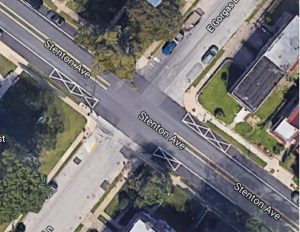 Winter is on its way, and with snow and ice, traffic accidents are only going to increase. One northwest Philadelphia neighborhood has seen enough though. The intersection of Stenton Avenue and Gorgas Lane has residents concerned. Nobody has died in a traffic accident there yet, but neighbors are predicting that a fatality is inevitable.
Winter is on its way, and with snow and ice, traffic accidents are only going to increase. One northwest Philadelphia neighborhood has seen enough though. The intersection of Stenton Avenue and Gorgas Lane has residents concerned. Nobody has died in a traffic accident there yet, but neighbors are predicting that a fatality is inevitable.
Broadside Accidents:
Most of the crashes at Stenton and Gorgas are broadsides (T-bones) when one vehicle crashes into the side of another at or close to a right angle. These are some of the most dangerous collisions that a motorist can be in. Most of the safety features of cars focus on frontal collisions. Those include bumpers, crumple zones, air bags and seat restraint systems. In rear-end collisions, drivers and occupants of the car that is hit are protected by bumpers, crumple zones and the back seat. Nearly all vehicles offer little protection on a side impact. There’s only the exterior body, the interior panel and some glass. Sometimes, a vehicle that has been broadsided gets knocked out of control. It’s a simple matter of physics, and as a result of the impact, it can crash into yet another motor vehicle or a stationary object like a telephone pole. That impact, a second or two after the first impact can end up in a rollover.
Broadside Accident Injuries:
Given the fact that there’s only minimal protection with a broadside impact, these types of accidents are physically serious. As per the National Highway Transportation Safety Administration, more than 8,000 people die every year in broadside crashes. When people are lucky enough to live through such a crash, injuries can consist of permanent traumatic brain and spinal cord damage, multiple fractures, joint injuries, organ damage and damage to vertebrae, discs and spinal nerves.
Causes of Broadsides at Stenton & Gorgas:
So why is this intersection so dangerous? There are several reasons why. Here are some examples of common driver behavior that results in accidents at intersections like Stenton and Gorgas:
- Failure to yield the right-of-way by not coming to a complete stop at a stop sign.
- Distracted driving, like talking on a cell phone or texting while approaching or going through an intersection with a stop sign.
- Poor sight lines and drivers being unable to fully see the intersection because of parked cars, signs, trees or other visual obstructions.
- Drivers being under the influence of alcohol, drugs or both.
- Speeding.
Would a Light Work?
Some residents have remarked that they want a traffic light at Stenton and Gorgas, but there’s already one just a block from the intersection for all four directions of traffic. The city believes that the high rate of accidents is from rolling stops rather than complete stops. One independent traffic engineer says that drivers on Stenton become conditioned because four-way stops are all along the street.
Comparative Negligence:
When accidents occur at Stenton and Gorgas, primary fault is usually attributable to the vehicle pulling out from the two stop signs at Gorgas. Drivers on Stenton might also share some fault, like if they failed to slow down to avoid a crash. That’s known as comparative negligence. In an injury claim or lawsuit, the percentage of fault attributable to that driver is deducted from any gross award that might be rendered. Pennsylvania is known as a modified comparative negligence state. So long as the claimant was less than 51 percent at fault for the accident, he or she can still recover damages.
Contact a Philadelphia Car Accident Lawyer.
Intersection accidents are second only to rear-end accidents in frequency, but they’ve been proven to be far more dangerous. After being injured in any crash that was caused by the carelessness and negligence of somebody else in or around Philadelphia, call 911 and seek immediate medical attention. Don’t give a statement of any kind to the opposing insurer. Politely refuse, and contact our Philadelphia car accident lawyers for a free consultation and case review. After that, we can discuss all of your legal options.
The post Car Accidents at Stenton Avenue and Gorgas Lane in northwest Philadelphia appeared first on The Pearce Law Firm, P.C..